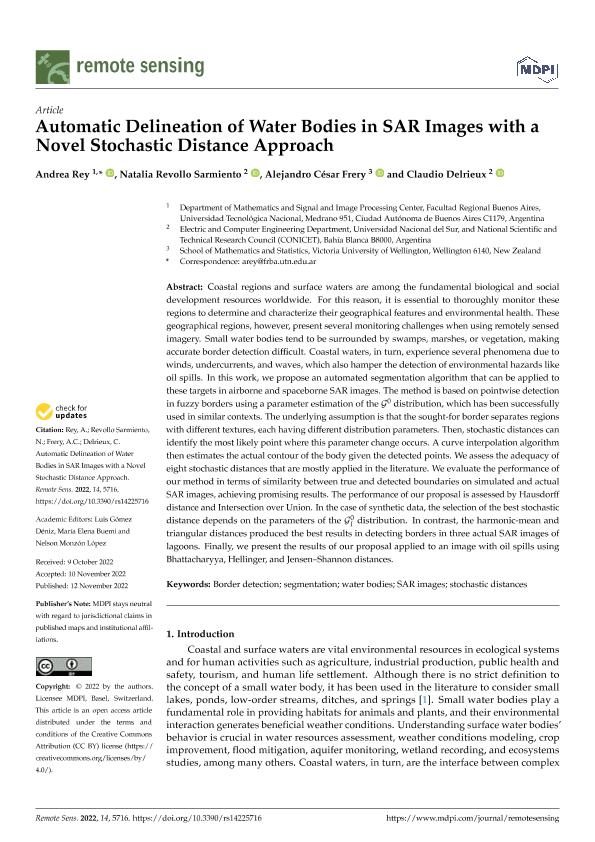Artículo
Automatic Delineation of Water Bodies in SAR Images with a Novel Stochastic Distance Approach
Rey, Andrea Alejandra ; Revollo Sarmiento, Natalia Veronica
; Revollo Sarmiento, Natalia Veronica ; Frery, Alejandro César; Delrieux, Claudio Augusto
; Frery, Alejandro César; Delrieux, Claudio Augusto
 ; Revollo Sarmiento, Natalia Veronica
; Revollo Sarmiento, Natalia Veronica ; Frery, Alejandro César; Delrieux, Claudio Augusto
; Frery, Alejandro César; Delrieux, Claudio Augusto
Fecha de publicación:
12/11/2022
Editorial:
MDPI
Revista:
Remote Sensing
ISSN:
2072-4292
Idioma:
Inglés
Tipo de recurso:
Artículo publicado
Clasificación temática:
Resumen
Coastal regions and surface waters are among the fundamental biological and social development resources worldwide. For this reason, it is essential to thoroughly monitor these regions to determine and characterize their geographical features and environmental health. These geographical regions, however, present several monitoring challenges when using remotely sensed imagery. Small water bodies tend to be surrounded by swamps, marshes, or vegetation, making accurate border detection difficult. Coastal waters, in turn, experience several phenomena due to winds, undercurrents, and waves, which also hamper the detection of environmental hazards like oil spills. In this work, we propose an automated segmentation algorithm that can be applied to these targets in airborne and spaceborne SAR images. The method is based on pointwise detection in fuzzy borders using a parameter estimation of the (Formula presented.) distribution, which has been successfully used in similar contexts. The underlying assumption is that the sought-for border separates regions with different textures, each having different distribution parameters. Then, stochastic distances can identify the most likely point where this parameter change occurs. A curve interpolation algorithm then estimates the actual contour of the body given the detected points. We assess the adequacy of eight stochastic distances that are mostly applied in the literature. We evaluate the performance of our method in terms of similarity between true and detected boundaries on simulated and actual SAR images, achieving promising results. The performance of our proposal is assessed by Hausdorff distance and Intersection over Union. In the case of synthetic data, the selection of the best stochastic distance depends on the parameters of the (Formula presented.) distribution. In contrast, the harmonic-mean and triangular distances produced the best results in detecting borders in three actual SAR images of lagoons. Finally, we present the results of our proposal applied to an image with oil spills using Bhattacharyya, Hellinger, and Jensen–Shannon distances.
Palabras clave:
BORDER DETECTION
,
SAR IMAGES
,
SEGMENTATION
,
STOCHASTIC DISTANCES
,
WATER BODIES
Archivos asociados
Licencia
Identificadores
Colecciones
Articulos (ICIC)
Articulos de INSTITUTO DE CS. E INGENIERIA DE LA COMPUTACION
Articulos de INSTITUTO DE CS. E INGENIERIA DE LA COMPUTACION
Articulos(IIIE)
Articulos de INST.DE INVEST.EN ING.ELECTRICA "A.DESAGES"
Articulos de INST.DE INVEST.EN ING.ELECTRICA "A.DESAGES"
Citación
Rey, Andrea Alejandra; Revollo Sarmiento, Natalia Veronica; Frery, Alejandro César; Delrieux, Claudio Augusto; Automatic Delineation of Water Bodies in SAR Images with a Novel Stochastic Distance Approach; MDPI; Remote Sensing; 14; 22; 12-11-2022; 1-21
Compartir
Altmétricas



